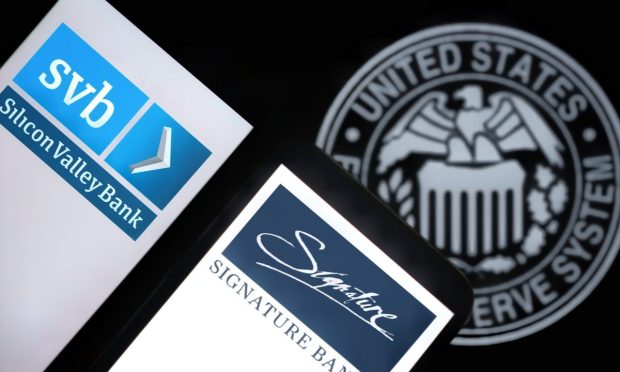Regulators Blame Signature for Own Failure and Themselves for SVB’s

In a scathing self-assessment, the Federal Reserve’s autopsy on Silicon Valley Bank’s failure puts blame partially on its own doorstep, as regulator reports on Signature Bank’s collapse cite the lender’s “poor management.”
The autopsy on failure has been released ahead of schedule.
The 114-page unflinching and, at times, self-critical post-mortem review of the central bank’s oversight and regulation of SVB, which was promised by the Fed’s vice chair for supervision, Michael Barr, during contentious congressional hearings last month, was compiled in just over six weeks and published Friday (April 28).
Both the Federal Deposit Insurance Corporation (FDIC) and the New York State Department of Financial Services (NYDFS) also released their own respective reports Friday on Signature Bank’s subsequent failure.
“These collapses represent a massive failure in supervision over our nation’s banks,” Sen. Elizabeth Warren of Massachusetts said.
While the FDIC and NYDFS lay much of their blame for Signature’s failure at the bank’s own feet, the Fed’s latest report reads in line with Warren’s assessment.
The mea culpa review, conducted by Barr, documented how lax supervision and loosened regulation, combined with poor executive management, led to SVB’s collapse.
SVB “failed because of a textbook case of mismanagement by the bank,” the review stated. “Its senior leadership failed to manage basic interest rate and liquidity risk. Its board of directors failed to oversee senior leadership and hold them accountable. And Federal Reserve supervisors failed to take forceful enough action…”
All three regulatory reviews concluded that the banking industry needs stricter policing across multiple fronts in order to prevent future failures.
Limited Intervention From Supervisors
SVB grew rapidly, from $71 billion to over $211 billion in assets between 2019 and 2021, but the bank’s tripling in size did not lead to it being subjected to heightened supervisory or regulatory standards.
“Supervisors did not fully appreciate the extent of the vulnerabilities as [SVB] grew in size and complexity,” the review stated. “When supervisors did identify vulnerabilities, they did not take sufficient steps to ensure that [SVB] fixed those problems quickly enough.”
“[T]he firm’s rapid growth but slow transition to heightened standards contributed to the slow identification of risks and slow pace of supervisor action,” added the review, emphasizing that going forward, the Fed needs to effectively evaluate “how to ensure that supervision intensifies at the right pace as a firm grows in size or complexity.”
Based on the Fed’s report, SVB had 31 open supervisory findings when it failed — nearly three times the comparable number of unstaffed positions relative to its peers.
Still, SVB was rated satisfactory in terms of management for both the holding company and the bank from 2017 through 2021, despite repeated observations of weakness in risk management.
Lawmakers homed in on the Fed’s lack of urgency with regard to ensuring compliance at SVB during a House Financial Services Committee hearing last month.
“It seems like they blew you guys off, and you didn’t do anything,” Rep. Juan Vargas of California said.
“How come no one is mad at the bank for not responding?” asked Rep. Rashida Tlaib of Michigan.
The Fed’s report acknowledged these failures, stating in its review that, “there are weaknesses in regulation and supervision that must be addressed. Regulatory standards for SVB were too low, the supervision of SVB did not work with sufficient force and urgency…”
The First Bank Run to Take Place on Twitter
Deposit outflows at SVB were over $40 billion March 9, and management expected $100 billion more the next day. The unprecedented outflow led the California Department of Financial Protection and Innovation (CDFPI) to close the bank March 10.
“[T]he combination of social media, a highly networked and concentrated depositor base, and technology may have fundamentally changed the speed of bank runs,” the review stated.
Barr’s review went on to emphasize that social media enabled depositors to instantly spread concerns about a bank run, and modern digital capabilities enabled immediate withdrawals.
As a result, the Fed indicated it will evolve and adapt its supervisory capabilities to better address the realities of today’s digitized environment.
“[T]he Federal Reserve has begun to build a dedicated novel activity supervisory group to focus on the risks of novel activities (such as FinTech or crypto activities) as a complement to existing supervisory teams,” according to the review.
The review separately outlined a range of changes to bank oversight and regulation, including stronger deterrents against risk-taking, as well as possible curbs on incentive compensation for executives. The report criticized SVB for tying executive compensation too closely to short-term profits and the bank’s stock price.
“I agree with and support [Barr’s] recommendations to address our rules and supervisory practices,” Federal Reserve Chair Jerome Powell said in a press release accompanying the report.
Signature’s Failure
The liquidation of Silvergate Bank and the collapse of SVB created a rapidly spreading panic that felled Signature Bank due to the lender’s “poor management” and inadequate risk policing practices, according to the FDIC.
“The primary cause of SBNY’s failure was illiquidity precipitated by contagion effects…,” the FDIC found in its report. “However, the root cause of SBNY’s failure was poor management.”
“Signature’s response to this crisis was hampered by a control framework that did not develop in line with the bank’s growth, and a liquidity management plan that did not match the bank’s risk profile,” the NYDFS report said.
Admitting shortcomings within its own department, the FDIC blamed a lack of staff in its New York office on the “high cost of living in New York, competition from other regulators and private sector firms that can pay more for talent than the federal government.”
Observers believe that the three, critical reports indicate bank regulations will be tightened — although it may take years for any proposals to be implemented.

